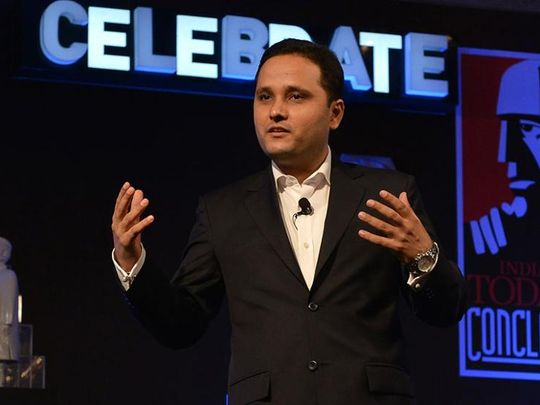
‘Biscuits.’ ‘If there’s one thing I must have by my side before I sit down to write, it’s several packets of cream biscuits.’
Amish Tripathi – household name in India, award-winning author of five books on Hindu mythology, consumer of snack foods – pauses for a moment.
‘Actually there are two things that aid my writing,’ he says. ‘Cream biscuits and music. It could be any genre of music – pop, reggae, metal, Indian classical, Bollywood, regional; it only has to suit the mood of my day’s writing.’
The 43-year-old, who hasn’t looked back since his first book, The Immortals of Meluha (2010), made him a literary star almost overnight – thanks in large measure to some clever marketing tactics (but more about that later) – is basking in the success of his latest book, Sita: Warrior of Mithila.
The second in his five-part Ramachandra series, Sita was published earlier this year. ‘It tells the story of Sita, a main character in the Indian epic Ramayan, from her birth until she was abducted by Ravan, another leading character in the epic,’ says Amish, whose works have been translated into 19 languages, with over four million copies of his works in print.
Four years ago, in 2013, publishing house Westland Amish received a $1m advance for his next series after his third book the mythological fantasy ‘The Oath of the Vayuputras’ sold more than 500,000 copies within a day of its release. It was said to be the largest payout by an Indian publisher at the time.
Ask him about the advance and he says, ‘honestly, I don’t really enjoy talking a lot about money’.
But ask him what are the best lessons he has learnt over the years since he picked up the pen, and he would say they all have to do with marketing. ‘The most important lessons I’ve learnt are how to market a book,’ he says, in a telephone interview from his home in Mumbai.
That’s no surprise, though. A graduate from the venerable Indian Institute of Management in Kolkata, Amish worked in the financial sector for 14 years before trying his hand at writing something other than project reports.
‘My first book The Immortals of Meluha was a result of a conversation I had with my family while watching a televised historical series Ramayan,’ says the soft-spoken writer. The TV series led to a debate on what would ensue if two groups with radically opposite views on mythology met. ‘My family must have found my arguments interesting because they suggested I write them down,’ says Amish.
He did, then bounced the manuscript past a couple of family members, incorporated some of their suggestions, revised the manuscript and over a few months the arguments morphed into a thriller of sorts.
But that was only half the job. Getting the work published was a much more difficult task. Amish presented his debut manuscript to more than 20 publishers. None bought it.

‘Although I was getting those rejection slips, I was not depressed or upset. While I did not guess that it would become a bestseller, I wanted to do everything I could to see it published,’ says the writer who now has a cult following.
With major publishing houses shutting the door, Amish finally decided to get his agent to publish the book. But he had a condition. ‘I said I’d invest in and manage the marketing of the book,’ says the author.
‘I’m lucky that I have a very smart wife. She [Preethi Vyas] was responsible for several marketing strategies that we employed for my first book.’
An unprecedented book marketing tactic was to print thousands of copies of the first chapter of the book and give them away free of cost at bookstores. ‘The idea was that if people like the first chapter they would return to buy the book,’ says Amish. ‘It was quite like how a shampoo manufacturer would make small sample satchets of the product for the public to test. Preethi felt that if it would work for an FMCG [fast moving consumer goods] product it would also work for a book.’
It did.
That was not all. A trailer not unlike that of a movie was also made and uploaded on Youtube, supposedly a first in Indian publishing. The book launch was done with a lot of fanfare including a pyrotechnic show, actors dressed like characters moving around in the crowd and large posters of the protagonist dotting the venue.
If the book received mostly positive critical responses, commercially it was a resounding success.
‘It’s a fallacy to think that good marketing can sell a bad book,’ Amish says quickly. ‘Equally, it’s a fallacy to think that a good book will sell itself. While a book needs to be worth the while of a reader, it also needs to be marketed well so the reader knows that it’s available in the market.’
If Preethi and a team that includes a few other members of his family direct part of the marketing strategy, Amish likes to ‘take credit for the fact that I clear the plan of action and then support every one of the marketing strategies.
‘The author has to be a totally creative person; he should be completely in control of the book and its content,’ he says. ‘You should write it the way you want to and not bother too much about what other people might say.’
Smoothly flipping to marketing, Amish stresses the importance of publicising the book. ‘I don’t believe that the author can take a back seat once the book is printed,’ he says. ‘I don’t believe in the concept where the author simply hands over his book to the publisher and doesn’t get involved with it. I know some authors even refuse to go on promotion tours of the book. But you have to be the CEO of your book.’
Amish poses a question to drive home his point: ‘Will you hand over your baby to a stranger and tell him ‘ok, you look after this baby, raise it’? Similarly, you can’t write away all your creativity to someone and just forget about it.’
Ever open to challenges, Amish says he decided to employ a ‘multilinear structure’ of storytelling for the five-part series based on the Ramayan.
‘The first book was on Rama, the second on Sita; the third will be on Ravan. The fourth and fifth books will have a common narrative interweaving the lives of these three main characters plus several others as well,’ he says.
The idea to experiment with this technique of storytelling came to him after watching Japanese filmmaker Akira Kurrosawa’s crime masterpiece Rashomon, in which the story is told from the viewpoints of several characters with often alternative or even contradictory versions of the same incident.
‘I must admit the idea sounded very cool to me before I started writing but once I got working on the book, I realised it’s pretty complex,’ he says. ‘There have been times when I thought that maybe I had bitten off more than I can chew.’
But Amish found the complexity a fun challenge. ‘It’s great fun. Also, readers seem to like complex writing. So yes, I thoroughly enjoyed writing Sita.’
Was he apprehensive when providing a different interpretation to one of Indian mythology’s most revered characters?
‘For many Indians, their impression of Sita is based on the popular [1980s TV serial] Ramayan, which was largely based on Tulsidas’ Ramcharitmanas, a modern interpretation of the original text,’ says Amish.
‘I’ve read the original text of Ramayan and several versions. In the original text, she is a far stronger character [than the one in the TV serial].’
In Amish’s book, Sita wields weapons, enters into battles and fights single-handedly. ‘People have written to me saying that this is a completely different perspective from what they had in mind. But then their perspective was based largely on a TV serial,’ says the author who was once an atheist but returned to faith when writing his first book.
Different perspectives of the epics are not uncommon, he continues.
‘There are great recent classics in regional literature, many of which sadly are not translated in other languages. For instance, a book by renowned Malayalam writer M T Vasudevan Nair called Randamoozham [meaning second turn, in Malayalam] approaches the well-known Indian epic Mahabarata from a completely different perspective. I’ve read an English translation and was blown away because it is so brilliant.’
Which is his favourite book from the five he has written?
‘That’s a difficult one,’ he says, with a laugh. ‘I like all of them, but if you were to force me, I’d say my first book, because I was entering an absolutely new field.’
Amish, who has been ranked five times consecutively from 2012 to 2015 by Forbes magazine as one of the top 100 celebrities in India, says that one of the best things about being a successful author is ‘the joy of being able to do what one loves to do and actually get paid to do it. Honestly, there cannot be a greater joy.’
A lover of all genres of writing, he says he is drawn a bit more towards non-fiction. ‘Mythology, lore, philosophy, history are what I also enjoy reading,’ he says.
And what are the books he’s reading right now?
‘I often read more than one book at a time,’ says Amish. ‘I’m reading Mahabarat Murders by Arnab Ray and Sapiens: A Brief History of Humankind by Yuval Noah Harari.
‘I’m also on the last few pages of The Ocean of Churn: How the Indian Ocean Shaped Human History by Sanjeev Sanyal. The last two are fantastic.’
What advice would he have for first time authors?
‘Most importantly, if you are holding a job, don’t junk it. Always consider writing as a second profession. Quit your job only when your royalty cheque is more than your salary cheque.
‘That’s what I did,’ he says. ‘I wrote my first book while holding on to a regular job. And you can find time - there are weekends, after office hours, etc when you can indulge in your passion. Or, you should find time to do what your heart wants you to.
‘Remember, there is no dishonor in having another job while considering writing a vocation.’
Amish compares writing to the world of film or sport.
‘Not everyone can expect to earn as much as [Bollywood actors] Shah Rukh Khan or Salman Khan from his/her first film. Or believe that you will earn as much as [Indian cricketers] Virat Kohli or R Ashwin as soon as he enters the arena.
‘Writing is like a high-risk game. A few lucky people make more money than they ever thought possible. But even during those times you need to remember that it could just be a lucky phase. Most don’t even make enough to pay their regular bills.’
If you are successful over a long period, then that’s definitely icing on the cake. Or in the case of Amish, the cream in the biscuits.











